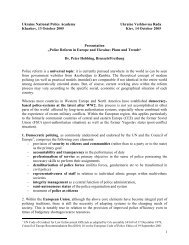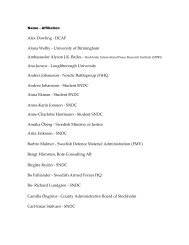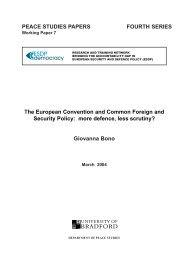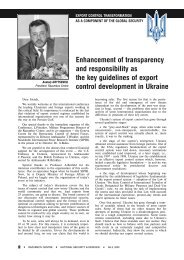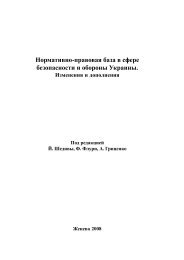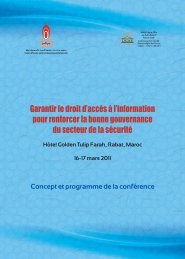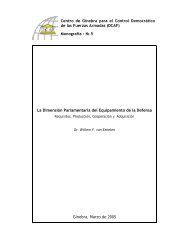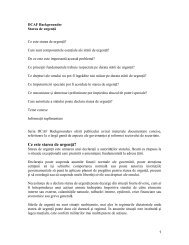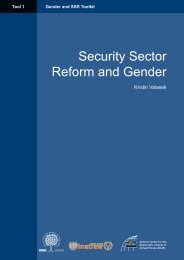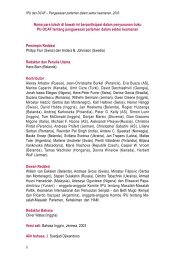Civil-Military Relations and Democratic Control of the Security Sector
Civil-Military Relations and Democratic Control of the Security Sector
Civil-Military Relations and Democratic Control of the Security Sector
Create successful ePaper yourself
Turn your PDF publications into a flip-book with our unique Google optimized e-Paper software.
Legal Norms <strong>and</strong> Institutions<br />
What is really important is <strong>the</strong> set <strong>and</strong> definitions <strong>of</strong> criteria to be relevant, useful <strong>and</strong> underst<strong>and</strong>able.<br />
The criteria should give to <strong>the</strong> actors <strong>of</strong> democratic control an instrument for objective<br />
analysis <strong>and</strong> decisions. For this purpose a set <strong>of</strong> criteria could be designed based on <strong>of</strong>ficially<br />
agreed or mutually accepted documents such as <strong>the</strong> OSCE Code <strong>of</strong> Conduct <strong>and</strong> <strong>the</strong><br />
NATO PfP criteria from <strong>the</strong> Study <strong>of</strong> NATO Enlargement (1995) <strong>and</strong> also popular check-lists as<br />
presented by scholars <strong>and</strong> experts as Chris Donnelly, Marco Carnovale (NATO Review, March<br />
1997), Jeffrey Simon (Joint Force Quarterly, 2000), admiral Henry Gaffney (Center for Naval<br />
Analyses Pr<strong>of</strong>essional Paper, 1996) <strong>and</strong> o<strong>the</strong>rs like <strong>the</strong> Center for European <strong>Security</strong> Studies’<br />
project as <strong>of</strong> 2001, entitled Organizing National Defenses for NATO Membership – The Unexamined<br />
Dimension <strong>of</strong> Aspirants’ Readiness for Entry (here <strong>the</strong> criteria are integrated in so-called<br />
“Carnovale-Simon test”).<br />
Part IV<br />
THE LEGAL NORMS AND THE INSTITUTIONS, PROVIDING THE<br />
LEADERSHIP AND THE DEMOCRATIC CONTROL OF THE SECURITY<br />
SECTOR IN THE DEMOCRATIC SOCIETY<br />
The establishment <strong>of</strong> <strong>the</strong> rule <strong>of</strong> law is at <strong>the</strong> very heart <strong>of</strong> a successful transition to <strong>and</strong> consolidation<br />
<strong>of</strong> democracy. The adoption <strong>and</strong> enforcement <strong>of</strong> constituent legal acts, such as <strong>the</strong> Constitution,<br />
is <strong>of</strong> central importance to <strong>the</strong> rule <strong>of</strong> law. The transformation <strong>of</strong> a whole series <strong>of</strong> state<br />
institutions to serve rule <strong>of</strong> law, ra<strong>the</strong>r than <strong>the</strong> agencies <strong>of</strong> repression, is one <strong>of</strong> <strong>the</strong> significant<br />
preconditions for both successful transition <strong>and</strong> progressive consolidation <strong>of</strong> democracy. While<br />
no single model is in <strong>of</strong>fer, Simon Lunn (Connections no. 4, 2002) has summarized <strong>the</strong> best<br />
practices in building preconditions for effective democratic control over <strong>the</strong> armed forces as<br />
follows:<br />
Legal <strong>and</strong> constitutional mechanisms which clarify <strong>the</strong> relationships between <strong>the</strong> head <strong>of</strong><br />
state, <strong>the</strong> government, parliament, <strong>and</strong> <strong>the</strong> armed forces in terms <strong>of</strong> <strong>the</strong> division <strong>of</strong> authority,<br />
comm<strong>and</strong>, <strong>and</strong> subordination in both peacetime <strong>and</strong> <strong>the</strong> transition to war;<br />
An appropriate mix <strong>of</strong> military <strong>and</strong> civilian personnel within MoD (including civilian Minister <strong>of</strong><br />
Defense) to ensure that <strong>the</strong> military expertise is situated in appropriate political <strong>and</strong> economic<br />
context;<br />
Effective parliamentarian oversight to ensure democratic legitimacy <strong>and</strong> popular support;<br />
Maximum transparency <strong>and</strong> openness, including independent research institutes <strong>and</strong> an<br />
active inquisitive media;<br />
Armed forces at ease with <strong>the</strong>ir role in society.<br />
Concerning <strong>the</strong> definition <strong>of</strong> democratic control over <strong>the</strong> armed forces <strong>and</strong> its mechanisms,<br />
<strong>the</strong> concept has two aspects. Once it is understood as “civilian” in <strong>the</strong> sense <strong>of</strong> “non-military,”<br />
vested to <strong>the</strong> respective state authorities. In o<strong>the</strong>r instances – as “civil” in <strong>the</strong> sense <strong>of</strong> “non-<br />
29



